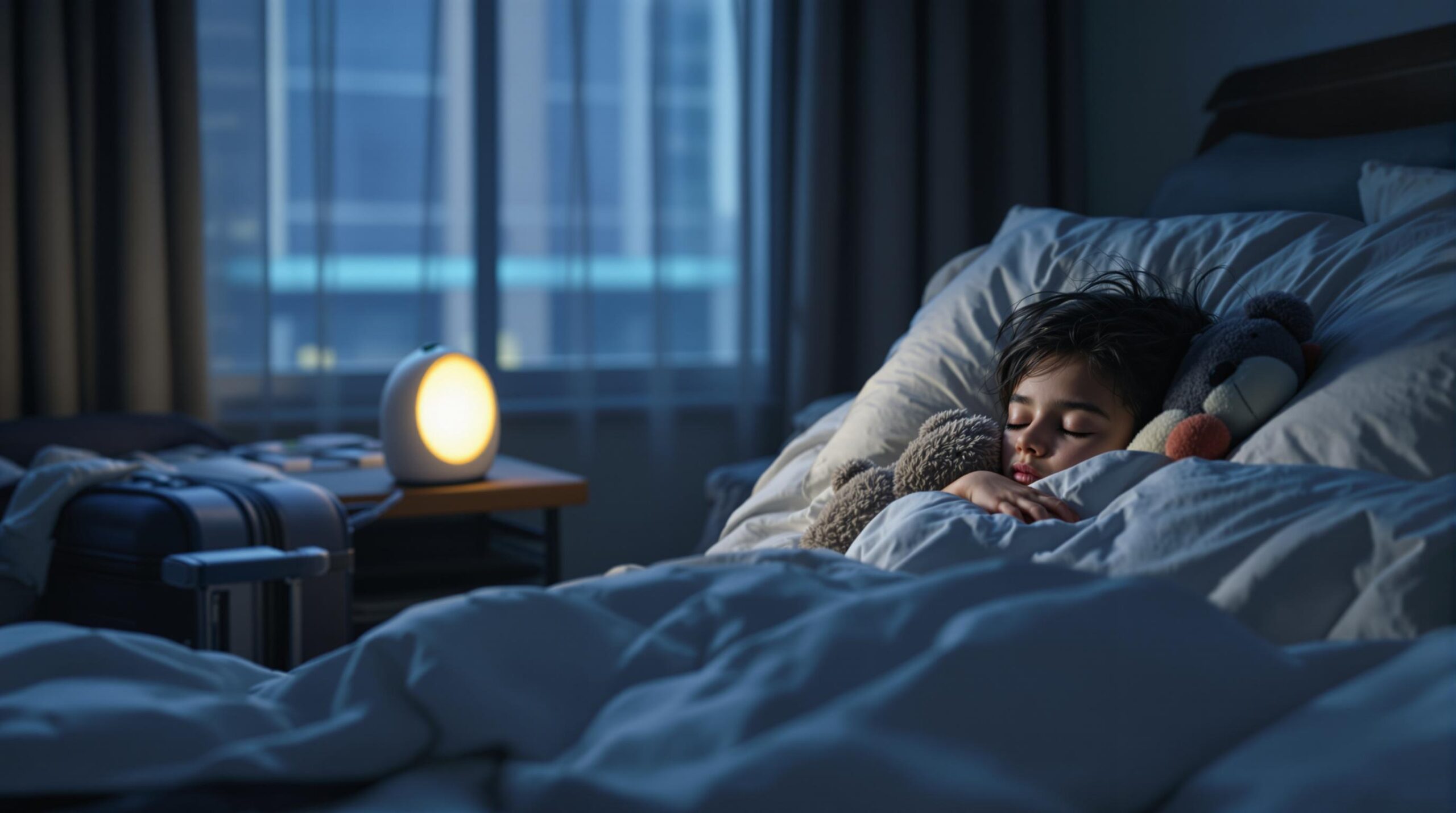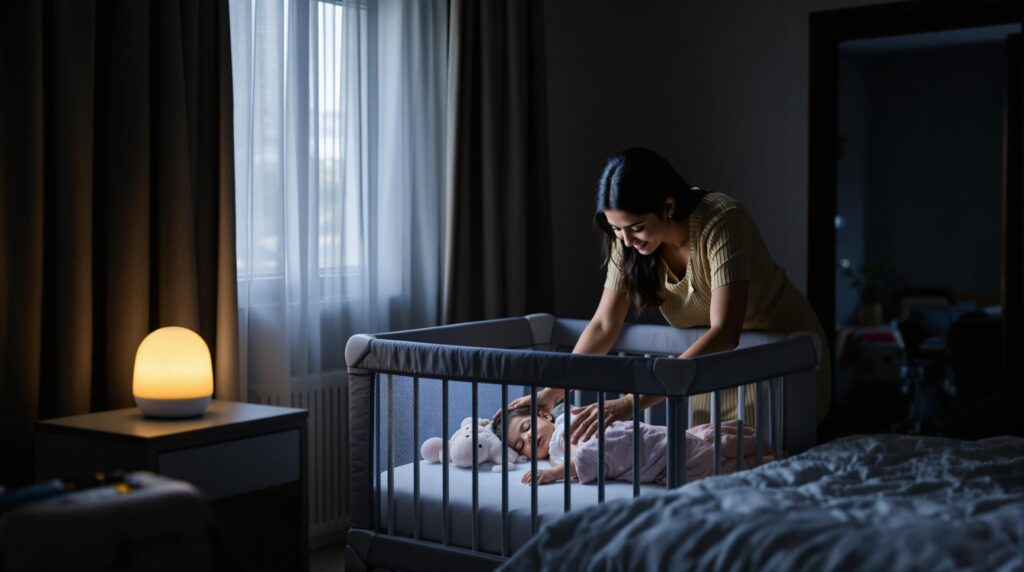Table of Contents
ToggleAs parents, we know how vital sleep is for our children’s growth and well-being. But what happens when we need to travel? Can we maintain our carefully crafted sleep routines while away from home? The good news is, with some planning and flexibility, it’s absolutely possible to keep your child’s sleep on track during your adventures.
The Importance of Consistent Sleep for Child Development
Sleep isn’t just about rest – it’s a cornerstone of healthy child development. During those precious hours of slumber, our little ones’ brains are busy processing information, consolidating memories, and laying the groundwork for future learning.
Jean Piaget, a renowned developmental psychologist, identified four stages of cognitive development that children go through as they grow. Each of these stages – sensorimotor, preoperational, concrete operational, and formal operational – has unique sleep requirements to support the developing mind.
For instance, during the sensorimotor stage (birth to 2 years), babies are learning about object permanence – the idea that things continue to exist even when they can’t be seen. This concept is crucial for sleep training, as it helps infants understand that you’ll return even if they can’t see you at bedtime.
As children progress through the stages of sleep training, their sleep needs evolve. Toddlers in the preoperational stage (2-7 years) may experience more vivid dreams as their symbolic thought develops, potentially leading to nighttime wake-ups. Understanding these developmental changes can help us adapt our sleep strategies accordingly.
It’s also worth noting that certain developmental milestones can throw a wrench in established sleep patterns. For example, the onset of separation anxiety around 9 months can make bedtime more challenging. By recognizing these hurdles, we can approach them with patience and understanding.

Creating a Sleep-Friendly Environment While Traveling
When we’re away from home, our goal is to recreate a sleep environment that feels familiar and comfortable to our children. This doesn’t mean packing your entire nursery, but rather focusing on key elements that signal “bedtime” to your little one.
Replicate the Home Sleep Environment
Start by bringing along some familiar bedding – perhaps a favorite blanket or pillowcase. The familiar scent and texture can be incredibly comforting. If your child uses a white noise machine at home, consider downloading a white noise app on your phone to use while traveling.
Maintain Consistent Bedtime Routine
Your bedtime routine is your secret weapon against sleep disruptions while traveling. Whether it’s a warm bath, storytime, or a lullaby, try to stick to your usual sequence of events. This predictability helps your child wind down and prepare for sleep, even in an unfamiliar setting.
Create a Dark and Quiet Sleeping Area
Light and noise can be major sleep disruptors. Pack a few clothespins to secure hotel curtains, or bring along a portable blackout shade. For noise, consider earplugs for older children or a travel sound machine for little ones.
Bring Comfort Items
Don’t forget to pack your child’s favorite stuffed animal, blanket, or other comfort item. These familiar objects can provide a sense of security in a new environment.
Gradual Introduction to New Environments
If possible, let your child explore the new sleeping area during the day. This can help them feel more comfortable when bedtime rolls around. You might even make setting up the sleep space a fun activity you do together.
Maintaining Sleep Routines During Travel
Consistency is key when it comes to sleep, but travel often demands flexibility. Here’s how to strike a balance:
Stick to Regular Bedtime Schedule
Try to keep bedtimes and wake times as close to normal as possible. If you’re crossing time zones, gradually adjust your child’s schedule in the days leading up to your trip. Aim for shifting bedtime by no more than an hour each day.
Be Prepared to Adjust
Sometimes, despite our best efforts, things don’t go according to plan. Maybe your flight is delayed, or an exciting activity runs late. In these cases, be prepared to adapt. A slightly later bedtime is okay occasionally, as long as you return to your routine as soon as possible.
Involve Your Child
Let your child help set up their sleep space. This can give them a sense of control and make the new environment feel more familiar. For older children, you might let them choose where to place their favorite stuffed animal or which pajamas to wear.
Use Technology Wisely
While we generally want to limit screen time before bed, certain apps can be helpful for maintaining sleep routines while traveling. Consider using a bedtime routine app that guides your child through their pre-sleep activities, or a sleep tracking app to help you maintain consistent wake times.
Communication and Parental Involvement
Clear communication is crucial when it comes to maintaining sleep routines while traveling, especially if you’re sharing caregiving responsibilities.
Ensure All Caregivers Are on the Same Page
If you’re traveling with a partner, grandparents, or other caregivers, make sure everyone understands your child’s sleep routine and needs. Discuss bedtimes, wake-up times, and any specific sleep associations your child has.
Open Communication with Your Partner
If you’re co-parenting, it’s essential to be on the same page about your sleep training approach. Discuss how you’ll handle potential sleep disruptions before they occur. Will you take turns with night wakings? How will you respond if your child resists bedtime?
Explain the Importance of Sleep to Your Child
For older children, explaining why sleep is important can help them buy into the idea of maintaining their routine while traveling. You might say something like, “Getting enough sleep helps your body grow strong and your brain remember all the fun things we’re doing on our trip!”
Health and Safety Considerations
While maintaining sleep routines is important, safety should always be our top priority when traveling with children.
Conduct Thorough Safety Checks
Before settling your child into a new sleep environment, do a careful safety check. Look for potential hazards like unsecured furniture, accessible windows, or dangling cords. In hotel rooms, check for any small objects left behind by previous guests that could pose a choking hazard.
Address Potential Hazards
If you identify any safety concerns, address them immediately. This might mean moving furniture, covering electrical outlets, or requesting a different room if necessary. Remember, it’s always better to be overly cautious when it comes to our children’s safety.
Maintain a Clean Sleep Environment
Keeping your child’s sleep area clean and hygienic is crucial, especially when traveling. Consider bringing your own fitted sheet for cribs or pack-n-plays, and don’t hesitate to give surfaces a quick wipe-down with disinfectant wipes.
Adapting to Challenges and Setbacks
Even with the best preparation, travel can sometimes throw a wrench in our carefully laid sleep plans. Here’s how to handle potential setbacks:
Understand That Disruptions May Occur
First and foremost, accept that some sleep disruption is normal when traveling. Your child might take longer to fall asleep, wake up more frequently, or rise earlier than usual. This doesn’t mean your sleep training efforts have failed – it’s a normal response to a change in environment.
Be Patient and Flexible
Patience is key when dealing with sleep challenges on the road. If your child is struggling to settle, resist the urge to immediately change your approach. Sometimes, a few extra minutes of comforting or an additional story can help ease the transition.
Maintain Consistency Where Possible
While flexibility is important, try to maintain as much consistency as you can. If your child is fighting bedtime, stick to your usual response as much as possible. This consistency will help your child feel secure and understand that sleep expectations remain the same, even in a new place.
Return to Routine Quickly
If sleep does get off track during your travels, don’t panic. Instead, focus on returning to your normal routine as quickly as possible once you’re back home. Most children will readjust within a few days to a week.
Remember, overcoming sleep training setbacks is part of the journey. With patience, consistency, and a bit of flexibility, you can help your child maintain healthy sleep habits, even when you’re away from home. Happy travels and sweet dreams!
Sources:
Piaget’s Stages: 4 Stages of Cognitive Development & Theory
Development Milestones
The NICHD Study of Early Child Care and Youth Development
Consumer Education Websites: A Guide to Creating a Family-Friendly Experience
American Academy of Pediatrics: Healthy Sleep Habits
National Sleep Foundation: Sleep and Travel
CDC: Sleep and Sleep Disorders
HealthyChildren.org: Sleep
National Institute of Child Health and Human Development: Sleep












